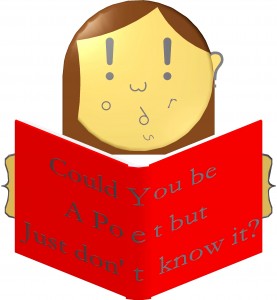Beginners’ Page
Hi, it’s lovely to meet a likeminded person!
If you’ve read “About me” you will know that I am just an ordinary wife and mum who happened upon poetry in June 2008 at my son’s school poetry morning. I got a taster of a few different poem forms, and started writing from there. Though I attended as an adult, I learned everything at Primary school level (aged 7 to 11 years), and referred to my children and to the internet to answer my specific questions if I wasn’t sure about something.
This website is my attempt to put everything that I have learned and enjoyed together so that you can become self-taught with less of the internet searching that I did!
My experience has shown me that all I really needed to know to get started is the basics as they are taught to primary children, with just a few extras. These are the details that I have put together on the TEACHERS’ PAGE so that they can teach them effectively to children. Therefore, please consider yourself a teacher (of self) and learn by following the examples that I explained via the Teachers’ Page, and the example poems in the poem categories above (specifically POEM FORMS & FIGURATIVE POEMS). Remember that, as I write for teachers also, these pages are dual purpose but, having learned the way I have, I know that the childrens’ activities are just as beneficial to a beginner and I have used them all as part of my own development. (Besides, I like to make poetry fun!)
If you would like to start with the basics of rhyme, rhythm and why and how to use them, these details are provided via this beginners’ page. I have found it really helpful to the development of my own poetry since I began to understand the patterns that are to be found in rhyme and in rhythm, as I am now able to use them to benefit my poems and to make them feel more natural and to flow better. Previously, I had found it too daunting to study rhyme and rhythm simply because of the complex words and definitions that are used, but once I was able to break down that barrier and grasp the logic, I have been able to go back to my first poems and use this understanding to help with the editing so hopefully it will help you too. See my pages on MAKING SENSE OF RHYME AND RHYTHM, RHYME PATTERNS, RHYTHM POETRY etc for a simple explanation of these concepts.
The POEM INDEX provides direct links to all of my poems individually (arranged alphabetically by title) so if you would simply enjoy reading them without all of the teaching, just go direct via the index, but if you would like to study any aspect of poetry specifically use the poem categories above to find example poems as all of my poems will be duplicated into each category as appropriate (many poems will be relevant to more than one category).
Moving on…..
I have recently begun to read a book by Stephen Fry called “The Ode Less Travelled” which explains the ‘rules’ of poetry in a way that I had not previously understood, so I am now progressing my own understanding from a natural, instinctive level to a (hopefully) educated one. I would recommend this book when you are ready to look deeper into rhythms and metres, stresses etc, but for now I shall give you a basic overview to get you started.
One final really handy hint….
If you write poetry sat at a computer, have the website www.rhymezone.com open as you write. It provides definitions, rhymes synonyms etc for any individual word so is invaluable as a dictionary, thesaurus and rhyming dictionary at the touch of a button.
It’s a tip a very good poet friend of mine gave me, and I’ve found it very useful. You’ll enjoy her website www.josiespoems.webeden.co.uk too as we share the same passion for making poetry fun and within reach for everyone.

Comments on this entry are closed.